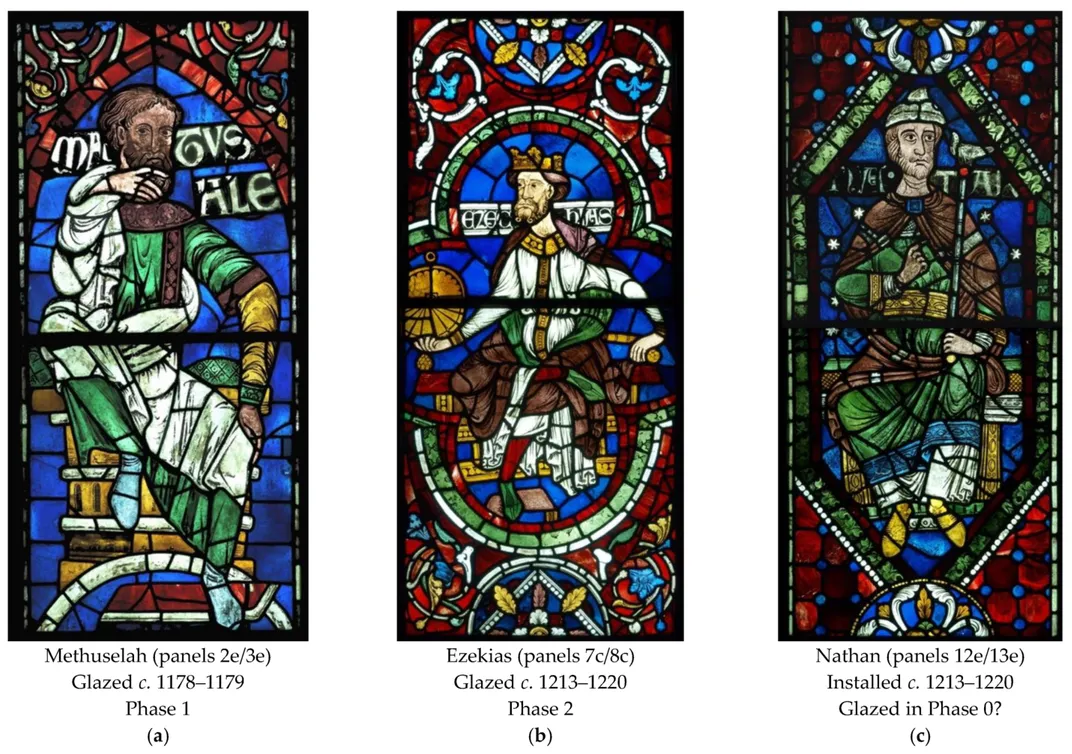Canterbury Cathedral’s 12th-Century Stained Glass May Be England’s Oldest
New research suggests four of the English church’s intricate windows were in place when Henry II’s men murdered Thomas Becket in 1170
:focal(415x220:416x221)/https://tf-cmsv2-smithsonianmag-media.s3.amazonaws.com/filer/5d/bd/5dbd11b9-550a-4bd8-beb0-aaff6f4c6a6f/nathan_stained_glass.jpg)
Some of the stained glass at England’s Canterbury Cathedral may have been created as early as the 1130s—a timeline that would make the panels the oldest surviving stained glass windows in the country, according to a new chemical analysis published in the journal Heritage.
For the study, conservators and scientists from University College London (UCL) investigated a series of 86 windows known as the Ancestors of Christ, reports Lydia Chantler-Hicks for Kent Online. Most of the glass panels were installed at the cathedral as part of a rebuilding effort following a fire in 1174. But the new analysis finds that several actually date to before the fire, meaning they were probably in place when soldiers serving Henry II murdered Thomas Becket at the cathedral’s altar in December 1170.
Léonie Seliger, head of stained glass conservation at the cathedral, tells BBC News’s Pallab Ghosh that she was “ready to dance” when she heard the news. She adds that the windows “would have witnessed the murder of Thomas Becket, they would have witnessed Henry II come on his knees begging for forgiveness, they would have witnessed the conflagration of the fire that devoured the cathedral in 1174. And then they would have witnessed all of British history.”
The team began investigating the windows as the result of a suggestion made by Tufts University historian Madeline Caviness in the 1980s. She’d argued that stylistically, four of the panels installed in the 13th century appeared to have been created much earlier.

UCL archaeologist Laura Ware Adlington developed a technique for analyzing the windows without removing physical samples. The process uses a portable X-ray fluorescence spectrometer outfitted with a specially designed, 3-D-printed attachment dubbed the “windolyzer.”
The results show that one of the stylistically distinct windows—a panel depicting the prophet Nathan—was crafted from older glass than others installed around the same time. The team suspects that the four panels were originally located in the choir of the pre-fire cathedral and escaped the flames largely intact. They may have been put in storage after the disaster and then installed in the reconstructed building.
In a statement, Ware Adlington describes the agreement between Caviness’ art-historical analysis and the chemical method as “rather remarkable—down to details such as Nathan’s hat, which she identified as an early 13th-century addition, and the scientific data confirmed was made with the later glass type found at Canterbury.”
Caviness, who is now 83, tells BBC News she was “delighted” to hear about the new research.
“The scientific findings, the observations and the chronology of the cathedral itself all fit together very nicely now,” she says. “I wish I was younger and could throw myself more into helping Laura with her future work. But I’ve certainly got a few more projects to feed her.”
/https://tf-cmsv2-smithsonianmag-media.s3.amazonaws.com/filer/f5/b8/f5b86e37-d408-4ecd-91af-1654746b9ca5/panels.jpg)
As Kelly Richman-Abdou wrote for My Modern Met in 2019, artisans developed stained glass—glass colored using metallic oxides—over many centuries. Romans used it to create objects such as the Lycurgus Cup as early as the fourth century C.E. In the seventh century, Europeans began creating stained glass windows for religious buildings such as St. Paul’s Monastery in Jarrow, England, but no known original examples from that time survive today.
“The earliest existing stained glass windows in Europe are believed to date to the 1130s,” says Seliger in the statement. “This study suggests that some of the Canterbury Ancestors may also date to this very early period.”
Per the Independent’s David Keys, the four older panels remained in the cathedral’s “extreme east end” until the late 18th century, when they were split between the church’s Great South and West Windows. During the English Civil Wars, Puritan Richard Culmer destroyed the stained glass that originally occupied these spaces, leaving vacancies to be filled some 150 years later.
According to co-author Ian Freestone, research on stained glass windows in the past has been stymied by the lack of non-destructive methods for chemical analysis.
“The results on Nathan are exciting not only for the information they provide about this important window but also because they show we have a methodology which works, and which will allow us to learn a lot more,” he says in the statement.
/https://tf-cmsv2-smithsonianmag-media.s3.amazonaws.com/accounts/headshot/Livia_lg_thumbnail.png)
/https://tf-cmsv2-smithsonianmag-media.s3.amazonaws.com/accounts/headshot/Livia_lg_thumbnail.png)